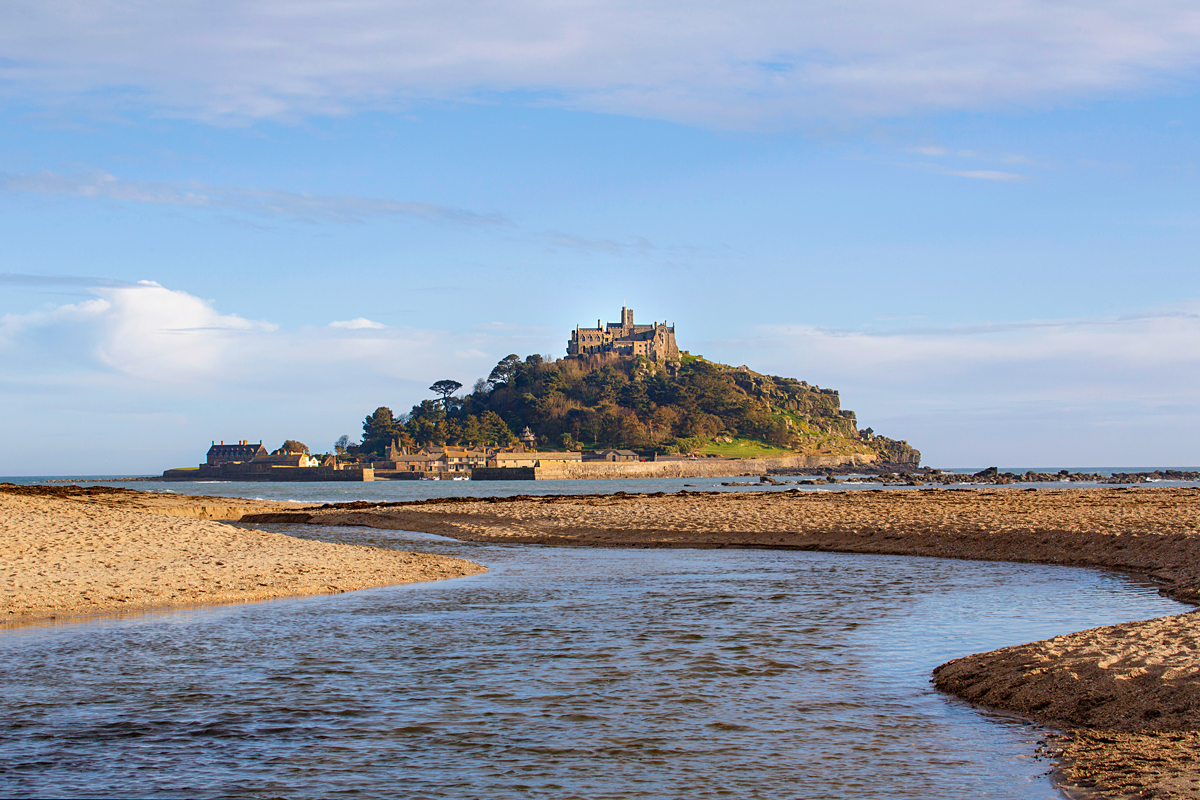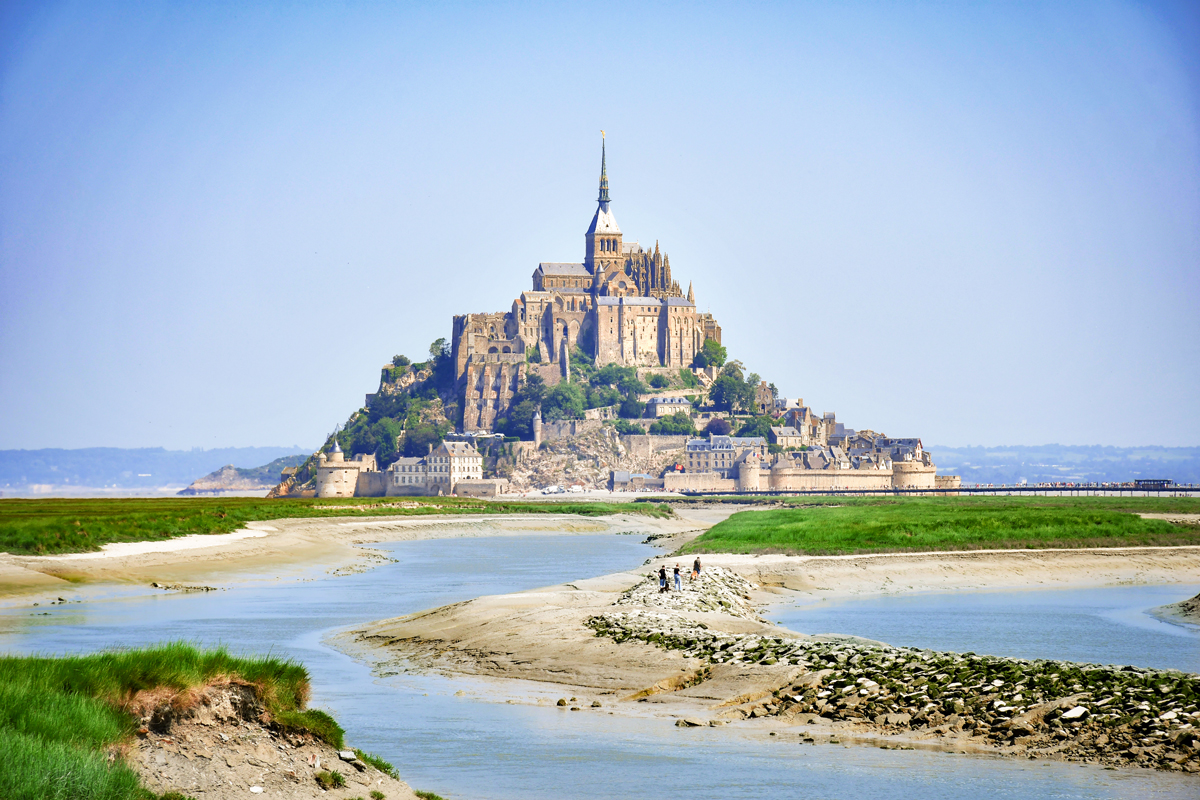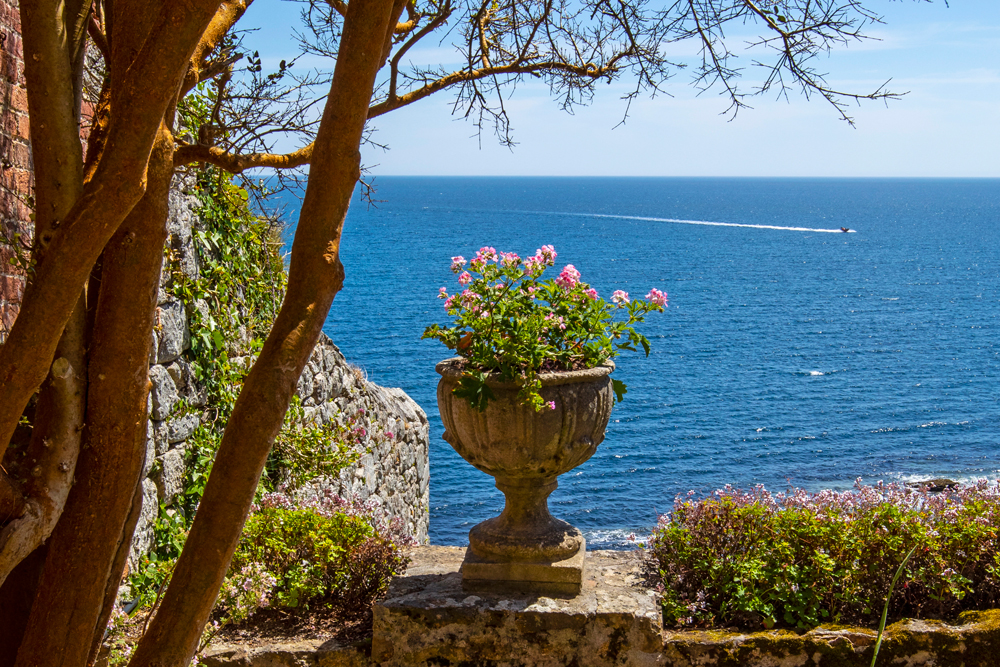Last June, we visited the famous Mont Saint-Michel in Normandy. This was our first visit to the famous monument under blue skies and at low tide. But I'd known for a long time that there was an English counterpart to our iconic French monument: St Michael's Mount.
Located at the southwestern tip of the island of Great Britain, this English Mont Saint-Michel bears some fascinating similarities to its French counterpart. Let me take you on a little tour with ten exciting anecdotes.
🎦 Watch our short video on the Mont Saint-Michel, which will inspire you to explore this historic site in France ⤵
Stay around St Michael's Mount
Click here for accommodation suggestions around St Michael's Mount or browse the map below:
10 fun facts about St Michael's Mount
1. An island accessible at low tide
St Michael's Mount is an island accessible at low tide in Mount Bay, Cornwall, near the market town of Penzance.
![St Michael's Mount Causeway © Adrian Farwell - licence [CC BY 3.0] from Wikimedia Commons St Michael's Mount Causeway © Adrian Farwell - licence [CC BY 3.0] from Wikimedia Commons](https://frenchmoments.eu/wp-content/uploads/2023/07/St-Michaels-Mount-Causeway-©-Adrian-Farwell-licence-CC-BY-3.0-from-Wikimedia-Commons-scaled-1.jpg)
The causeway © Adrian Farwell - licence [CC BY 3.0] from Wikimedia Commons
The island is a civil parish linked to the village of Marazion by a granite causeway, which (like the beach) is passable between mid-tide and low tide.
In 1755, the Lisbon earthquake triggered a tsunami that hit the Cornish coast more than 1,600 km away. The sea rose by 2 metres in 10 minutes at St Michael's Mount and receded at the same rate. The waves continued to rise and fall for five hours.
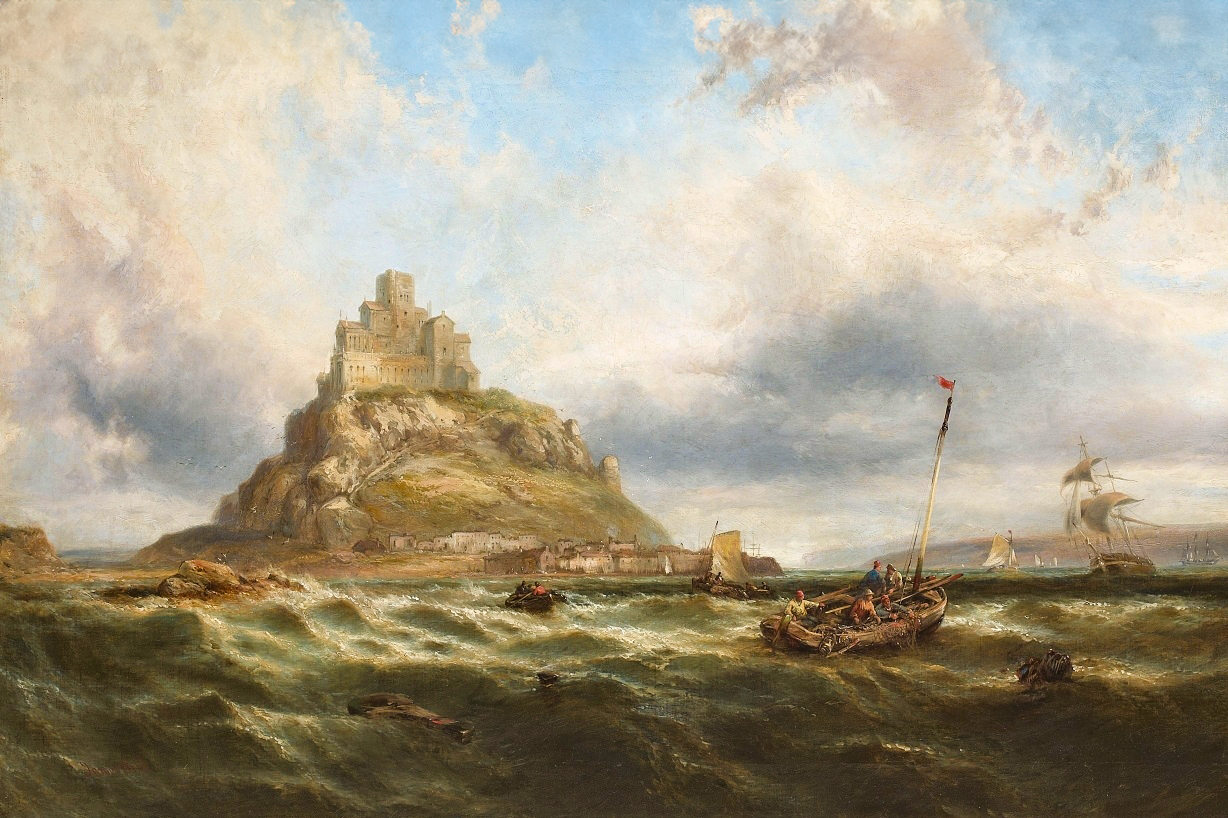
St Michael's Mount. Painting by James Well (1890s)
The causeway between the mountain and Marazion was raised by one foot (30 cm) in 1879 using sand and stones from the surrounding area. Following storm damage in the winter of 2014, repairs were completed in March 2016.
St Michael's Mount is one of 43 islands accessible at low tide without a bridge that can be reached on foot from Great Britain.
Part of the island was designated a Site of Special Scientific Interest in 1995 for its geology.
2. The old Cornish name for the island
Before taking the name of the Archangel Michael, St Michael's Mount was known in Cornish as Karrek Loos yn Koos, which literally means "the grey rock in a wood".
![St Michael's Mount Cornwall © Chensiyuan - licence [CC BY-SA 4.0] from Wikimedia Commons St Michael's Mount Cornwall © Chensiyuan - licence [CC BY-SA 4.0] from Wikimedia Commons](https://frenchmoments.eu/wp-content/uploads/2023/07/St-Michaels-Mount-Cornwall-©-Chensiyuan-licence-CC-BY-SA-4.0-from-Wikimedia-Commons-scaled-1.jpg)
© Chensiyuan - licence [CC BY-SA 4.0] from Wikimedia Commons
Was the mountain in the middle of a forest before the sea flooded the bay? A storm uncovered the remains of trees on the nearby beach of Perranuthnoe at low tide.
3. The English counterpart to Mont Saint-Michel
Historically, St Michael's Mount was the Cornish counterpart to Mont-Saint-Michel in Normandy.
The distance as the crow flies between the two Monts Saint-Michel is 330 km (205 miles).
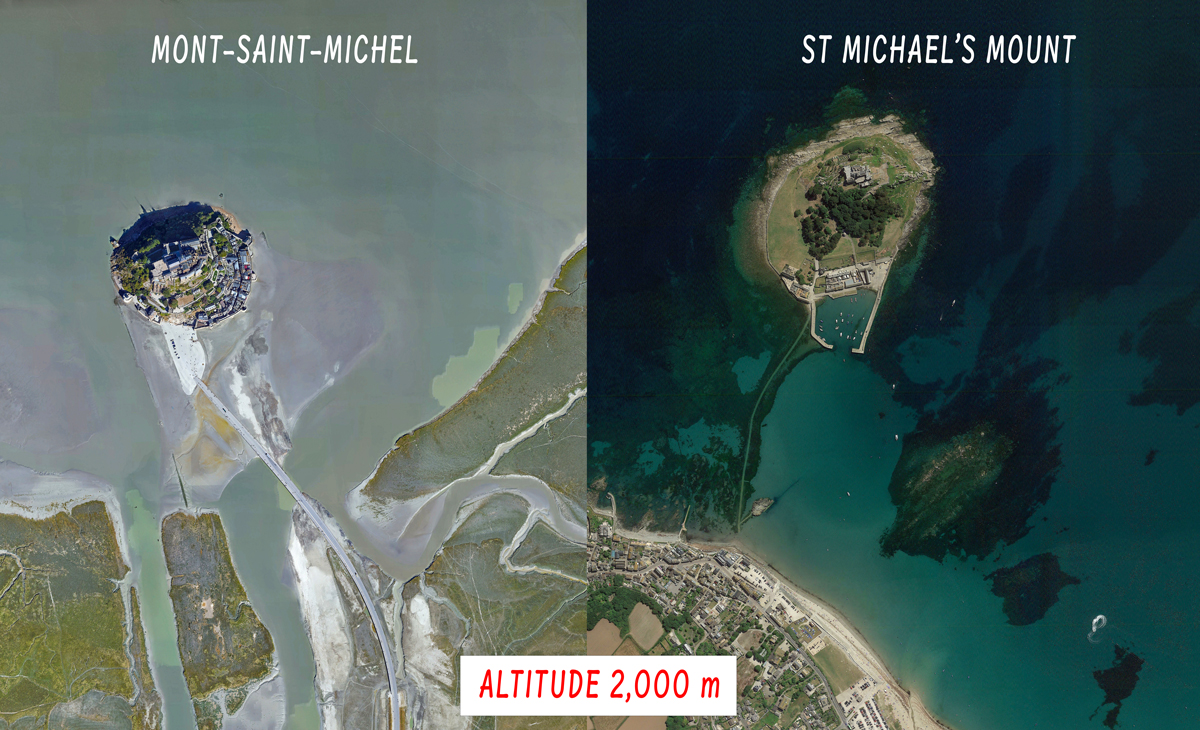
Comparison of the two Monts-Saint-Michel at the same altitude (by Google Earth)
Mont-Saint-Michel
Island width: 260 m x 290 m
Max. rock height: 80 m
Distance from coast: 370 m
St Michael's Mount
Island width: 410 m x 350 m
Max. island height: 60 m
Distance from coast: 520 m
Legend states that when the Normans conquered England in 1066, they were struck by the island's resemblance to their Mont-Saint-Michel. The topography prompted them to invite Benedictine monks to build a small abbey on top of the English island.
However, it is more likely that a monastery already occupied the site between the 8th and early 11th centuries. Edward the Confessor is said to have given the site to the Benedictine order of Mont Saint-Michel.
![St Michael's Mount 02 © Monster4711 - licence [CC0] from Wikimedia Commons St Michael's Mount © Monster4711 - licence [CC0] from Wikimedia Commons](https://frenchmoments.eu/wp-content/uploads/2023/07/St-Michaels-Mount-02-©-Monster4711-licence-CC0-from-Wikimedia-Commons-scaled-1.jpg)
© Monster4711 - licence [CC0] from Wikimedia Commons
The two rocky islands share some curious similarities.
- They are both accessible at low tide.
- They are both pyramid-shaped - although Mont Saint-Michel is much higher.
You need to climb 60 metres to reach the top of the English island, compared with 80 metres to reach the terrace of the abbey of Mont-Saint-Michel. The latter culminates at precisely 157.10 metres above sea level, thanks to the 4-metre-high golden statue of Saint Michael.
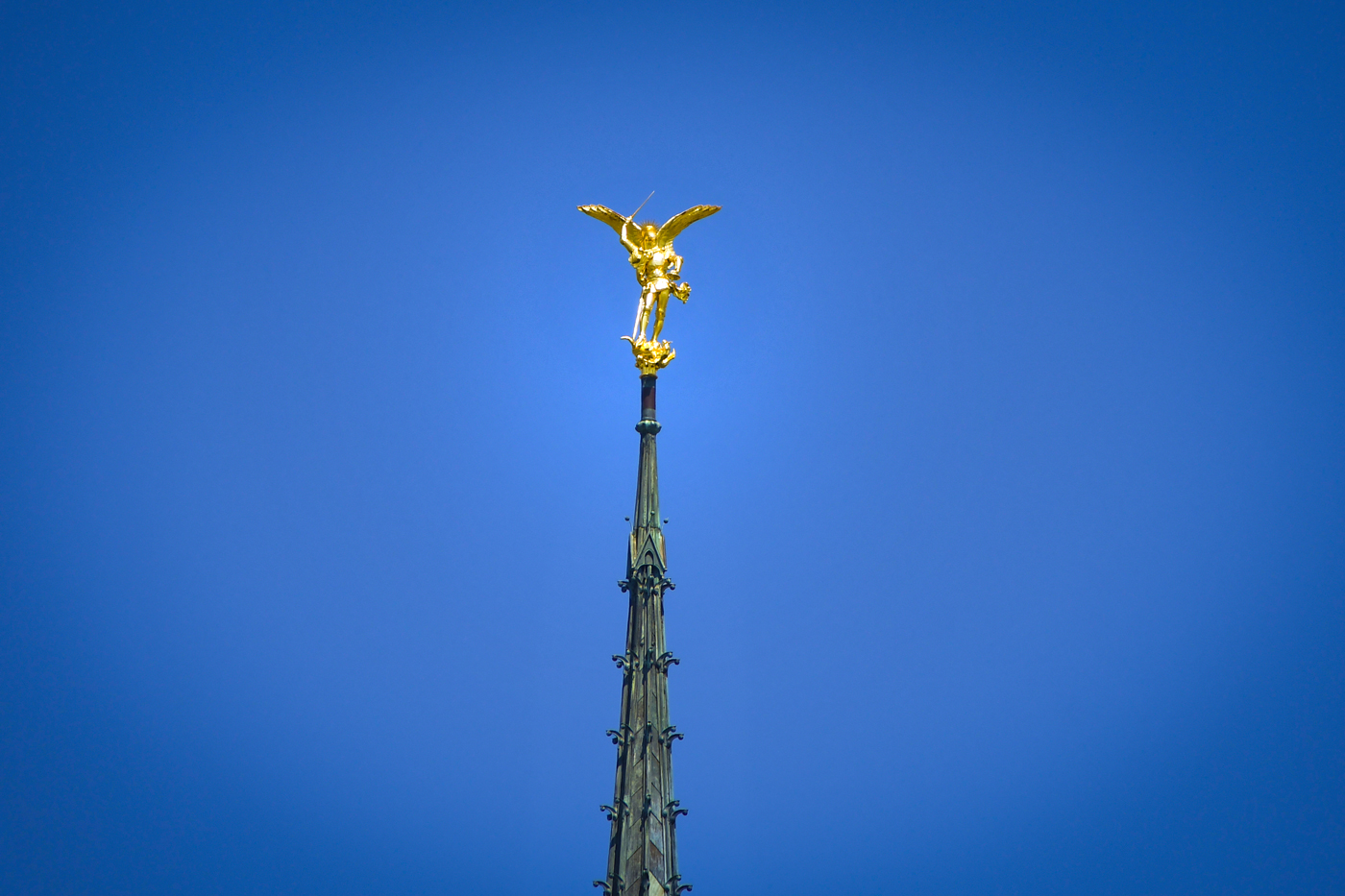
The Archangel Michael at the summit of Mont-Saint-Michel © French Moments
4. The legendary Ictis
The northeastern slopes of the island feature defensive stone embankments that probably date back to the beginning of the 1st millennium BC. A fortress seems to have existed on the edge of the cliff.
![St Michael's Mount Cornwall © Simon Cobb - licence [CC0] from Wikimedia Commons St Michael's Mount Cornwall © Simon Cobb - licence [CC0] from Wikimedia Commons](https://frenchmoments.eu/wp-content/uploads/2023/07/St-Michaels-Mount-Cornwall-©-Simon-Cobb-licence-CC0-from-Wikimedia-Commons-scaled-1.jpg)
© Simon Cobb - licence [CC0] from Wikimedia Commons
The mount is one of several candidates for the island of Ictis, described as a centre of the tin trade in the Bibliotheca Historica by the Greek-Sicilian historian Diodorus Siculus, writing in the first century BC.
While it is widely accepted that Ictis was an island off the south coast of present-day England, scholars continue to debate its precise location. Candidates include St Michael's Mount and Looe Island off Cornwall, the Mount Batten peninsula in Devon and the Isle of Wight further east.
![St Michael's Mount Village © Chris Combe - licence [CC BY 2.0] from Wikimedia Commons St Michael's Mount Village © Chris Combe - licence [CC BY 2.0] from Wikimedia Commons](https://frenchmoments.eu/wp-content/uploads/2023/07/St-Michaels-Mount-Village-©-Chris-Combe-licence-CC-BY-2.0-from-Wikimedia-Commons-scaled-1.jpg)
© Chris Combe - licence [CC BY 2.0] from Wikimedia Commons
5. Jack the giant killer
Jack the Giant-killer is an English folk tale set in the time of King Arthur.
In the 6th century, before a castle was built, legend has it that the island was home to Cormoran, an 18-foot (5.50 m) giant who lived in a cave with his ill-gotten treasures. The foul creature terrorised the towns and villages of the region.
One day, a young farmer's son named Jack attacked this gigantic menace, which had an appetite for livestock and children. He killed it by trapping it in a hidden pit and bringing his axe down on its head.
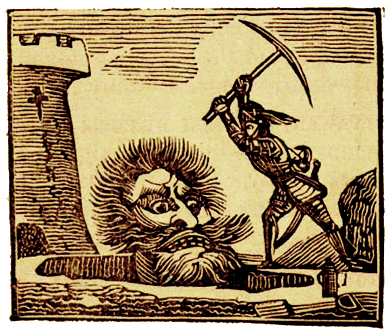
Cormoran the Giant
When he returned home, the village elders gave him a hero's welcome and therefore called him "Jack the Giant Slayer".
The story is reminiscent of another famous tale: Jack and the Beanstalk.
6. Royal Visits
The island's harbour was enlarged in 1823 to accommodate ships of up to 500 tonnes deadweight.
It has a jetty dating back to the 15th century, which has also been renovated.
![St Michael's Mount Cornwall © Rwendland - licence [CC BY-SA 4.0] from Wikimedia Commons St Michael's Mount Cornwall © Rwendland - licence [CC BY-SA 4.0] from Wikimedia Commons](https://frenchmoments.eu/wp-content/uploads/2023/07/St-Michaels-Mount-Cornwall-©-Rwendland-licence-CC-BY-SA-4.0-from-Wikimedia-Commons-scaled-1.jpg)
© Rwendland - licence [CC BY-SA 4.0] from Wikimedia Commons
Queen Victoria disembarked from the royal yacht to visit St Michael's Mount in 1846. A brass inlay of her footstep can be seen at the top of the pier.
You can see King Edward VII's footstep near the bowling green.
In 1967, the Queen Mother entered the harbour aboard a pinnace from the royal yacht Britannia.
The island has welcomed Queen Elizabeth II and the current King Charles III, then Prince of Wales.
7. A small village
Little is known about the village before the early 18th century, except there were a few fishermen's and monastic cottages.
After the harbour was improved in 1727, St Michael's Mount became a thriving seaport.
![St Michael's Mount Cornwall © Derek Voller - licence [CC BY-SA 2.0] from Wikimedia Commons St Michael's Mount Cornwall © Derek Voller - licence [CC BY-SA 2.0] from Wikimedia Commons](https://frenchmoments.eu/wp-content/uploads/2023/07/St-Michaels-Mount-Cornwall-©-Derek-Voller-licence-CC-BY-SA-2.0-from-Wikimedia-Commons.jpg)
© Derek Voller - licence [CC BY-SA 2.0] from Wikimedia Commons
In 1811, there were 53 houses and four streets. The pier was enlarged in 1821, and the population peaked in the same year when the island's population reached 221.
There were three schools, a Wesleyan chapel and three pubs, mainly frequented by passing sailors.
After significant improvements to the nearby port of Penzance and the extension of the railway to Penzance in 1852, the village declined, and many houses and other buildings were demolished.
The village, with its small number of houses, gives the English island a different appearance to that of Mont Saint-Michel in France.
![St Michael's Mount Village © Nilfanion - licence [CC BY-SA 4.0] from Wikimedia Commons St Michael's Mount Village © Nilfanion - licence [CC BY-SA 4.0] from Wikimedia Commons](https://frenchmoments.eu/wp-content/uploads/2023/07/St-Michaels-Mount-Village-©-Nilfanion-licence-CC-BY-SA-4.0-from-Wikimedia-Commons-scaled-1.jpg)
© Nilfanion - licence [CC BY-SA 4.0] from Wikimedia Commons
8. From Mont Saint-Michel's priory to a romantic château
At Mont Saint-Michel, a fortified abbey of impressive dimensions occupies the top of the rocky island. This contrasts with St Michael's Mount, where the buildings are more modest. There is no abbey here, just a castle!
![St Michael's Mount Castle © Marktee1 - licence [CC BY-SA 4.0] from Wikimedia Commons St Michael's Mount Castle © Marktee1 - licence [CC BY-SA 4.0] from Wikimedia Commons](https://frenchmoments.eu/wp-content/uploads/2023/07/St-Michaels-Mount-Castle-©-Marktee1-licence-CC-BY-SA-4.0-from-Wikimedia-Commons-scaled-1.jpg)
© Marktee1 - licence [CC BY-SA 4.0] from Wikimedia Commons
The priory
In the 11th century, Edward the Confessor donated the site to the Benedictine order of Mont-Saint-Michel. The establishment was a priory of the Norman abbey until the dissolution of the foreign houses as a side effect of the war in France by Henry V.
In 1414, as part of the Hundred Years' War waged in France by the English King Henry V, the Parliament of London decided to confiscate the "alien priories", i.e. all the priories and possessions of French abbeys on English soil.
Thus ended the association of the priory of St Michael's Mount with the abbey of Mont-Saint-Michel.
The priory ceased to exist in 1424 when the island was given to the abbess and convent of Syon in Isleworth, Middlesex.
![St Michael's Mount Church © Nilfanion - licence [CC BY-SA 4.0] from Wikimedia Commons St Michael's Mount Church © Nilfanion - licence [CC BY-SA 4.0] from Wikimedia Commons](https://frenchmoments.eu/wp-content/uploads/2023/07/St-Michaels-Mount-Church-©-Nilfanion-licence-CC-BY-SA-4.0-from-Wikimedia-Commons-scaled-1.jpg)
St Michael church © Nilfanion - licence [CC BY-SA 4.0] from Wikimedia Commons
The castle
However, the castle that stands on the summit of the island is not new... since the first buildings date back to the 12th century.
Renovations were carried out in the 18th and 19th centuries, giving it a character typical of romanticism in vogue at the time.
![St Michael's Mount Cornwall © Werner Wilmes - licence [CC BY 2.0] from Wikimedia Commons St Michael's Mount Cornwall © Werner Wilmes - licence [CC BY 2.0] from Wikimedia Commons](https://frenchmoments.eu/wp-content/uploads/2023/07/St-Michaels-Mount-Cornwall-©-Werner-Wilmes-licence-CC-BY-2.0-from-Wikimedia-Commons-scaled-1.jpg)
© Werner Wilmes - licence [CC BY 2.0] from Wikimedia Commons
The fortified complex combines the former priory, the main building and a chapel under one roof.
It has been the home of the St Aubyn family since Sir John St Aubyn acquired the island in 1659. His descendants still live there today!
![St Michael's Mount Roof Terrace © Derek Voller - licence [CC BY-SA 2.0] from Wikimedia Commons St Michael's Mount Roof Terrace © Derek Voller - licence [CC BY-SA 2.0] from Wikimedia Commons](https://frenchmoments.eu/wp-content/uploads/2023/07/St-Michaels-Mount-Roof-Terrace-©-Derek-Voller-licence-CC-BY-SA-2.0-from-Wikimedia-Commons.jpg)
© Derek Voller - licence [CC BY-SA 2.0] from Wikimedia Commons
A visite full of surprises
A visit to the castle will reveal a few nuggets:
- A crossbow for hunting hares and rabbits.
- A clock that tells you the time of the tide and the time of day.
- A frieze with hunting scenes, including an ostrich eating from a horseshoe.
- A piece of Napoleon's coat worn at the Battle of Waterloo.
- A statue of Saint Michael offering mercy to the devil at his feet.
- The sofa where Queen Victoria sat while her governess offered her a cup of tea.
- A mummified cat, a creepy souvenir of a trip to Egypt undertaken by the master of the house.
- An engraved window depicting a comical family scene: St Aubyn's inquiring daughter checks the authenticity of her diamond engagement ring before accepting her marriage proposal.
9. A filming location
Several films featured the mount:
- In 1979 the film Dracula represented the mount as the exterior of Dracula's castle.
- It appears in the 1983 James Bond film Never Say Never Again, when two guided missiles armed with nuclear warheads fly over the English countryside and sea, passing directly over Mount St Michael.
- In the 2003 film Johnny English, it was used as the exterior of French villain Pascal Sauvage's castle.
- Then, in 2012, it was used as the location for the fantasy adventure film Mariah Mundi and the Midas Box.
- Finally, in 2021, it was chosen for the Game of Thrones prequel series, House of the Dragon.
![St Michael's Mount Cornwall © Lewis Clarke - licence [CC BY-SA 2.0] from Wikimedia Commons St Michael's Mount Cornwall © Lewis Clarke - licence [CC BY-SA 2.0] from Wikimedia Commons](https://frenchmoments.eu/wp-content/uploads/2023/07/St-Michaels-Mount-Cornwall-©-Lewis-Clarke-licence-CC-BY-SA-2.0-from-Wikimedia-Commons-scaled-1.jpg)
© Lewis Clarke - licence [CC BY-SA 2.0] from Wikimedia Commons
10. A National Trust site still inhabited
The castle and chapel have been the home of the St Aubyn family since around 1650.
In 1954, Francis Cecil St Aubyn, 3rd Baron of St Levan, donated most of St Michael's Mount to the National Trust and a substantial endowment fund. The St Aubyn family retained a 999-year lease to live in the castle and a licence to run public tours of its historic rooms. This activity is managed in collaboration with the National Trust.
The site is open to visitors, including the castle and gardens.
![St Michael's Mount Gardens © Nilfanion - licence [CC BY-SA 4.0] from Wikimedia Commons St Michael's Mount Gardens © Nilfanion - licence [CC BY-SA 4.0] from Wikimedia Commons](https://frenchmoments.eu/wp-content/uploads/2023/07/St-Michaels-Mount-Gardens-©-Nilfanion-licence-CC-BY-SA-4.0-from-Wikimedia-Commons-scaled-1.jpg)
The island's gardens © Nilfanion - licence [CC BY-SA 4.0] from Wikimedia Commons
![St Michael's Mount Gardens © Bill Boaden - licence [CC BY-SA 2.0] from Wikimedia Commons St Michael's Mount Gardens © Bill Boaden - licence [CC BY-SA 2.0] from Wikimedia Commons](https://frenchmoments.eu/wp-content/uploads/2023/07/St-Michaels-Mount-Gardens-©-Bill-Boaden-licence-CC-BY-SA-2.0-from-Wikimedia-Commons-scaled-1.jpg)
View of the gardens from the castle © Bill Boaden - licence [CC BY-SA 2.0] from Wikimedia Commons
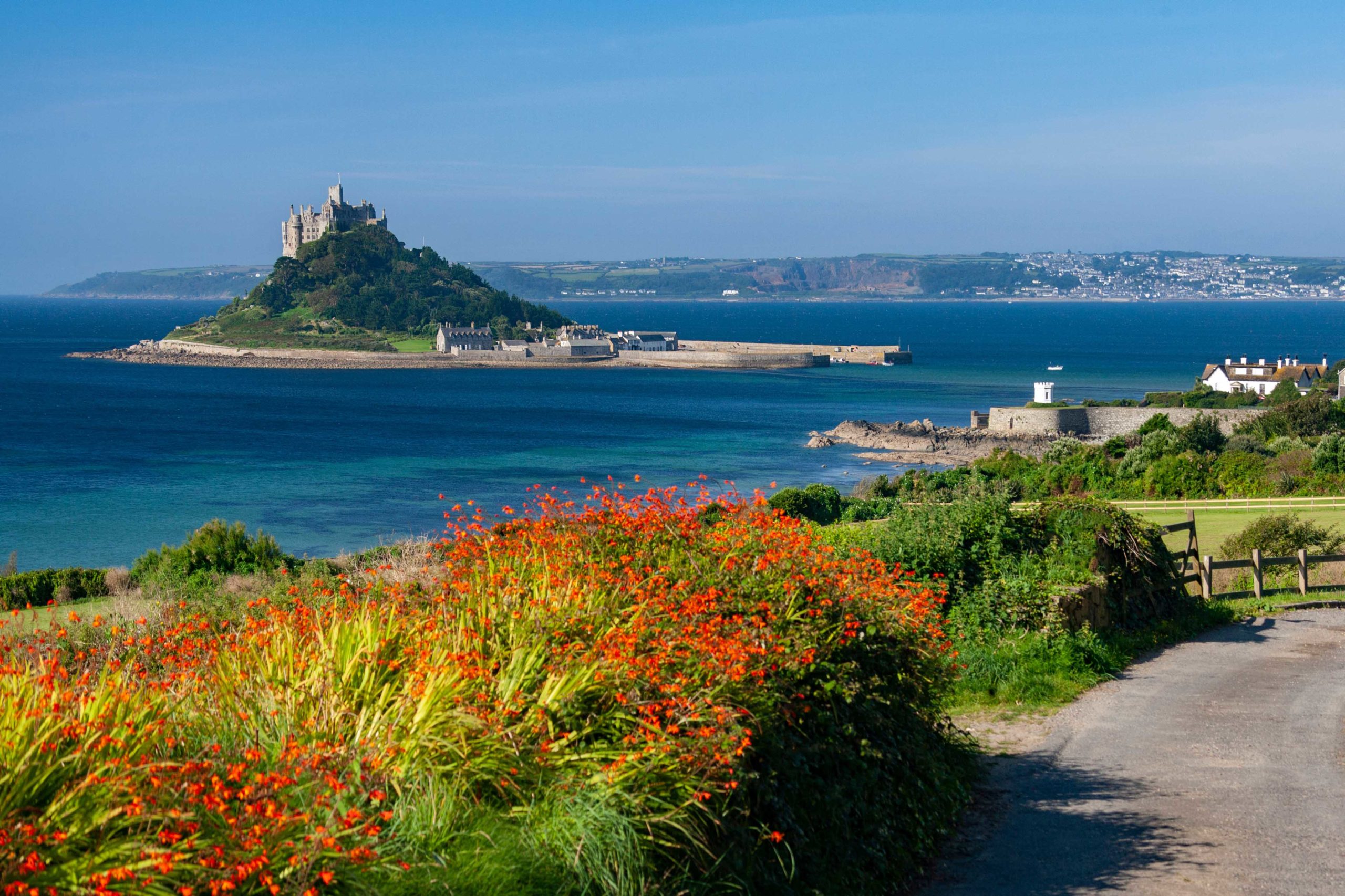
St Michael's Mount in Cornwall. Photo SteveAllenPhoto999 via Envato Elements
Practical tips for your visit
Getting to St Michael's Mount
The island of St Michael's Mount lies off the Cornish town of Marazion, 6 km east of Penzance. To find the car park (subject to a charge), use the postcode TR17 0EG for satellite navigation. The car park may be marked as Folly Field on your map - this is St Michael's Mount and Long Stay Marazion car park.
- 130 km / 81 mi from Plymouth (Ferry Terminal) - approximately 2hrs 15mins drive
- 310 km / 193 mi from Poole (Ferry Terminal) - about a 4-hour drive
- 385 km / 240 mi from Portsmouth (Ferry Terminal) - approx. 4hrs 45mins drive
- 450 km / 280 mi from central London (5h45).
Continue your visit: things to see in the area
The best thing is to stay around Penzance for a week. You'll then be able to take your time and explore the surrounding area at your leisure!
Here is a list of sites to discover in the region:
Access to the island
Access to the island depends on the tide.
At low tide:
The causeway is open for around four hours daily, depending on the tides and weather conditions. The ticketing system is aligned with the tidal times, so you can only book "walk" tickets when the causeway is clear.
Allow around 15 minutes to cross the causeway on foot to the first checkpoint, located at the island's base. There is no limit to the length of your stay on the island. Allow at least 3 hours to visit the castle, shops and cafés.
At high tide:
You will need to take a boat as the causeway will be closed. If a boat is required, this will be indicated at the time of purchase.
Boats depart from (and return to) one of three landing points on land, depending on the height of the tide: Chapel Rock, Gwelva and Top Tieb. Guides will tell you where to land your boat on the day (additional cost: £2.80 for an adult in 2023).
Your visit
- The car park (subject to a charge) is located in Marazion opposite St Michael's Mount.
- To visit the island (the castle and/or the garden), book your tickets at www.stmichaelsmount.co.uk.
- There are public toilets, a café and shops on the island.
- Dogs are not allowed on the island, except for assistance dogs.
Useful Links
- The Mount's official website
- The National Trust website
- My pages on Mont Saint-Michel Island and Mont-Saint-Michel Abbey
- Book your accommodation around St Michael's Mount.
- Read this page in French on our blog Destination Angleterre.
Featured Image: Photo by flotsom via Envato Elements
About the illustrations in the article
Most of the photos are ours (© French Moments). However, I have selected some photos (including the Featured Image of this article) from Depositphotos, a commercial platform that brings authors of high-quality licensed stock photos, graphics, vectors and videos together with appreciative buyers.



